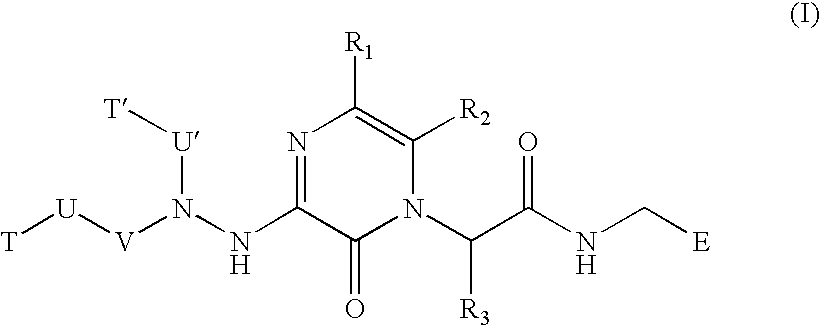Substituted hydrazinyl heteroaromatic inhibitors of thrombin
a technology of hydrazinyl heteroaromatic inhibitors and thrombin, which is applied in the field of compound compounds, can solve the problems of reduced or complete lack of blood flow to the affected organ, poor activation of protein c by thrombin in the absence of thrombomodulin, and reduced blood flow to the affected extremity, etc., and achieves elaborate potent mitogenic activity and poor activation of protein c by thrombin in the absence of thrombomodul
- Summary
- Abstract
- Description
- Claims
- Application Information
AI Technical Summary
Benefits of technology
Problems solved by technology
Method used
Image
Examples
example 1
Preparation of Ethyl N-(1-cyanoethyl)glycine (Step A)
##STR24##
To a suspension of glycine ethyl ester hydrochloride (3.0 g, 0.021 mol) in DCM (80 mL) was added Et.sub.3 N (3.0 mL, 0.021 mol). The resulting mixture was stirred at room temperature for 10 minutes, then acetaldehyde (1.2 mL, 0.021 mol) was added, followed by the drop-wise addition of TMSCN (2.86 mL, 0.021 mol). The resulting homogeneous solution was stirred at room temperature for 18 hours, then was diluted with DCM (100 mL) and washed with brine (100 mL), dried (Na.sub.2 SO.sub.4), and concentrated in vacuo. The crude mixture was purified by flash column chromatography on silica gel (7:3 EtOAc / hexane). The title compound (3.5 g, 87%) was isolated as its white, solid, hydrochloride salt. TLC R.sub.f (free base) 0.8 (EtOAc). .sup.1 H NMR (methanol-d.sub.4) .delta.1.34 (t, J=7.2 Hz, 3H), 1.73 (d, J=7.2 Hz, 3H), 4.16 (d, J=4 Hz, 2H), 4.33 (q, J=7.2 Hz, 2H), 4.70 (q, J=7.2 Hz, 1H).
example 2
Preparation of 3,5-dichloro-1-ethoxycarbonylmethyl-6-methylpyrazinone (Step B)
##STR25##
To a suspension of the compound of Example 1 (3.5 g, 0.018 mol) in 1,2-dichlorobenzene (20 mL), was added oxalyl chloride (6.34 mL, 0.074 mol). After stirring the resulting mixture at 110.degree. C. for 18 hours, the excess oxalyl chloride was quenched by adding coarse silica gel. The resulting mixture was purified by flash column chromatography on silica gel (DCM followed by 1:1 EtOAc / hexane) to afford the title compound (3.7 g, 82%) as a dark oil. TLC R.sub.f 0.6 (1:1 EtOAc / hexane). .sup.1 H NMR (CDCl.sub.3) .delta.1.32 (t, J=7.6 Hz, 3H), 2.41 (s, 3H), 4.28 (q, J=7.6 Hz, 2H), 4.84 (s, 2H).
example 3
Preparation of 5-chloro-1-ethoxycarbonylmethyl-3-hydrazino-6-methylpyrazinone (Step C)
##STR26##
To a solution of the compound of Example 2 (9.4 g, 0.036 mol) in dioxane (100 mL), was added hydrazine (3.35 mL, 0.107 mol). The resulting mixture was heated at 60 to 70.degree. C. After 2 hours, the reaction mixture was diluted with water (200 mL) and extracted with EtOAc (3.times.150 mL). The combined organic phases were washed with brine (300 mL), dried (Na.sub.2 SO.sub.4), and concentrated under reduced pressure to afford the title compound (7.3 g, 80%) as a pale yellow solid. TLC R.sub.f 0.8 (EtOAc). .sup.1 H NMR (CDCl.sub.3) .delta.1.30 (t, J=6.8 Hz, 3H), 2.28 (s, 3H), 3.9 (br s, 2H), 4.25 (q, J=6.8 Hz, 2H), 4.76 (s, 2H), 7.1 (br s, 1H).
PUM
| Property | Measurement | Unit |
|---|---|---|
| Molar density | aaaaa | aaaaa |
| Molar density | aaaaa | aaaaa |
| Molar density | aaaaa | aaaaa |
Abstract
Description
Claims
Application Information
 Login to View More
Login to View More - R&D
- Intellectual Property
- Life Sciences
- Materials
- Tech Scout
- Unparalleled Data Quality
- Higher Quality Content
- 60% Fewer Hallucinations
Browse by: Latest US Patents, China's latest patents, Technical Efficacy Thesaurus, Application Domain, Technology Topic, Popular Technical Reports.
© 2025 PatSnap. All rights reserved.Legal|Privacy policy|Modern Slavery Act Transparency Statement|Sitemap|About US| Contact US: help@patsnap.com



